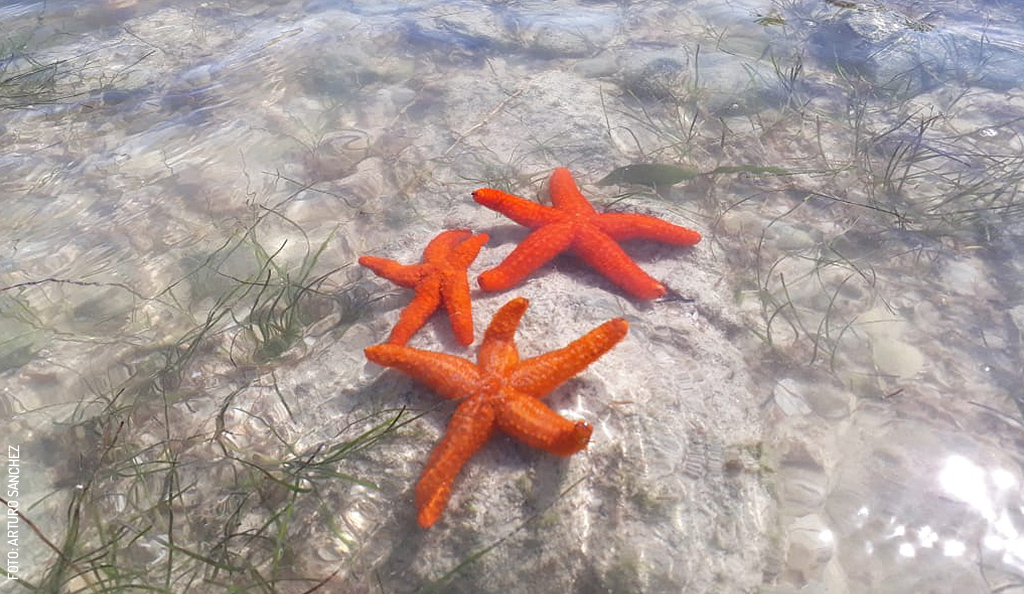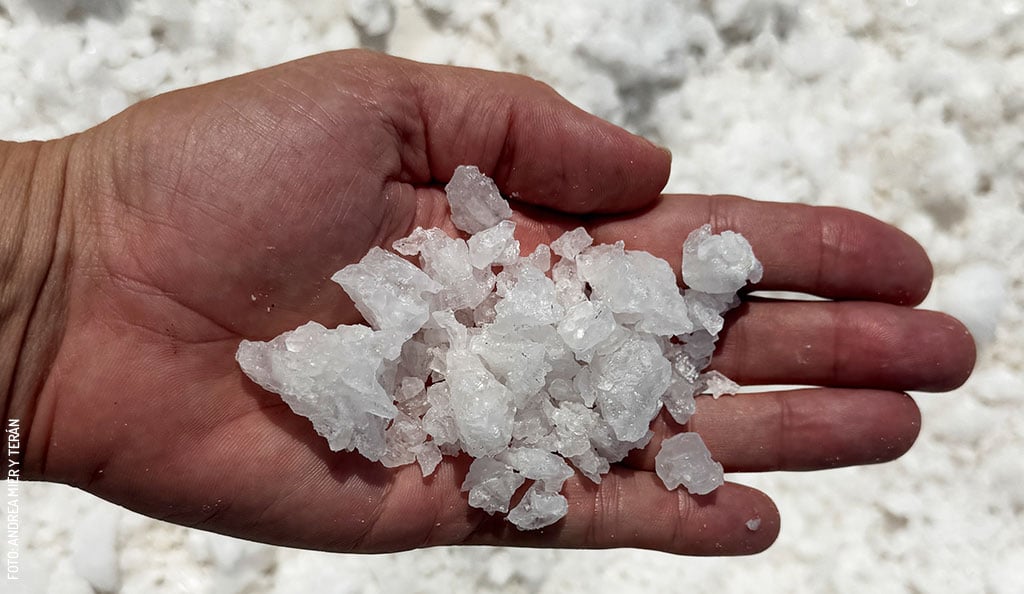
Beyond the Sand: The Living Ecosystem of the Yucatán Coast
Along the Yucatecan coast–from Celestún to El Cuyo, passing through Sisal, Progreso, Chicxulub, and Telchac–over 500 land and marine species thrive, many of which are endemic (meaning they’re found nowhere else on Earth). The biodiversity here is truly astonishing, ranging from migratory birds to tiny organisms hidden in the sand or mangroves.
So, paying close attention to the species around you when you’re at the beach can turn into a delightful and surprising experience. Here’s a closer look at some of the creatures you might encounter during your visit.
Where marine life begins

From the moment you kick off your sandals and step onto the sand, you’re entering a world teeming with small creatures. Among them are brown algae, commonly called “sargassum”, through many of these are actually types of “sea lettuce (Dictyota, Ulva). While they appear vibrant green and shiny underwater, they often look far less appealing once they wash up on the shore. The same goes for seagrasses (Syringodium filiforme), which look more like little “sticks” than leaves.
Even if their color (and scent, some might say) isn’t the most pleasant, sargassum plays a vital role: it provides shelter for tiny organisms and food for larger ones.
The shore: A shifting ecosystem

The sand along the shoreline hides surprises of its own. Beneath the surface, you might spot small species like chivitas (Nassarius spp.), tiny snails that burrow in the sand, or colorful little clams (Donax spp.). It also used to be common to find “weches” (mole crabs); you could scoop up a handful of sand and watch them scurry away–these little arthropods made excellent bait for fishing. Unfortunately, coastal erosion and the pressure of human presence have drastically reduced their numbers in recent decades.
Other sea creatures you might come across, though less frequently, include sea urchins and starfish. They’re not dangerous; in fact, we’re the ones who can harm them–taking them out of the water and exposing them to the warmth of our hands, even briefly, can be fatal.
In the water
If you venture a few steps into the sea and pay close attention, you might spot needlefish (Belonidae family) with their long, slender beaks swimming near the surface. Closer to the sand bottom, on clear-water days or with the help of a snorkel mask, you could see a pufferfish (Sphoeroides spp.) or a colorful juvenile bluehead wrasse (Thalassoma bifasciatum). Another common sight is the Yucatecan killfish (Fundulus persimilis), endemic to the region; if you visit any of the fishing piers along the Yucatecan coast, you’ll likely spot them swimming in large schools. None of the fish pose any danger to humans or will approach you (at least not on purpose), so it’s best to enjoy them from a respectful distance–no touching or scaring them.
Farther out at sea, where local fishers work each day, you’ll find larger species such as the red grouper (Epinephelus morio), which is common near coastal reefs; the Caribbean spiny lobster (Panulirus argus), prized for its taste, and the Mexican four-eyed octopus (Octopus maya), another species endemic to southeastern México.
You can read more about these species and local fishing practices in our article “Gone Fishing in Yucatán”.
Unexpected guests

Near the beach, among rocks or greenery, you might spot striped iguanas sunbathing. These reptiles, called “juj” in Maya, are often referred to as “toloks” by Yucatecos who don’t speak Maya. In mangrove areas like Celestún or Ría Lagartos, you may also catch sight of racoons or crocodiles, but always from a safe distance and with respect.
Between sky and sea

If you look up, you’ll see a variety of birds soaring through the sky. Brown pelicans are usually the first to dive into the water to catch fish, while gulls (Larus spp.), cormorants (Phalacrocorax auritus) and terns (Sterna hirundo) wait patiently for their turn. You’ll likely spot frigatebirds (Fregata magnificens) gliding above with their distinctive forked tails.
In quieter areas like sand dunes, you might also see tricolored herons (Egretta tricolor), snowy egrets (Egretta thula) and, if you’re lucky, roseate spoonbills (Platalea ajaja) with their wide, curious bills.
And of course, one of the most sought-after birds by visitors to Yucatán is the iconic American flamingo (Phoenicopterus ruber). While they’re more commonly seen in Celestún or Río Lagartos, you might also spot them flying along the coast.
Nightlife under the sea
 If you prefer watching the sunset by the sea, be careful not to step on the fast, tiny ghost crabs (Ocypode quadrata) that scurry across the sand. And if you’re incredibly lucky, you might witness a rare and breathtaking event: sea turtles coming ashore to lay their eggs. The most common species on the Yucatán coast are the green sea turtle (Chelonia mydas), the hawksbill turtle (Eretmochelys imbricata) and the loggerhead turtle (Caretta caretta).
If you prefer watching the sunset by the sea, be careful not to step on the fast, tiny ghost crabs (Ocypode quadrata) that scurry across the sand. And if you’re incredibly lucky, you might witness a rare and breathtaking event: sea turtles coming ashore to lay their eggs. The most common species on the Yucatán coast are the green sea turtle (Chelonia mydas), the hawksbill turtle (Eretmochelys imbricata) and the loggerhead turtle (Caretta caretta).
Very important: if you see a turtle on the beach, do not touch it or shine a flashlight at it under any circumstances! Instead, call the sea turtle hotline at Tel. 999 502 7825, and check out our article Observing Sea Turtles in Yucatán to learn what to do.
Their home is not your home
Observing Yucatán’s biodiversity is a privilege, but it also comes with responsibility. Here are a few tips to help protect wildlife during your visit:
- Avoid collecting live shells or snails. If there's a living creature inside, leave it where it belongs.
- Don’t feed the birds. It might seem harmless, but it disrupts their natural behavior and can make them sick.
- Walk carefully over wet sand, especially if you see clams, eggs, or signs of buried animals.
- Never drive motorized vehicles (ATVs, cars, etc.) on the beach.
- Take all your trash with you—even if it looks biodegradable. The wind can carry it into the ocean.
- Respect the dunes and coastal vegetation, where birds nest and many insects and reptiles live.
Visiting the beaches of Yucatán is about more than sun and sea–it’s an opportunity to reconnect with nature and learn how to coexist with it. If you look closely and act respectfully, you’ll leave not just with beautiful photos, but with meaningful memories that help preserve these ecosystems for generations to come.
First published in Yucatán Today print and digital magazine no. 450, in June 2025.

Author: Goretty Ramos
Feminist communicator with delusions of an artist and screen printer. Research, learn and share.
In love with Yucatán? Get the best of Yucatán Today in your email.
Don't miss our best articles and the monthly digital edition before anyone else.
Related articles

The White Gold of Xtampú: A Salt Worker’s Tale
Explore Yucatán's ancient Xtampú salt pans, where Don José the salt worker shares his tales of tradition, history, and the "white gold" of the Maya....
Visions of the Past: a Visit to the Fototeca Pedro Guerra
Mérida film photography journey with a vintage Rolleicord, inspired by Mariana Yampolsky. Exploring Fototeca Pedro Guerra's Yucatán history archive.




